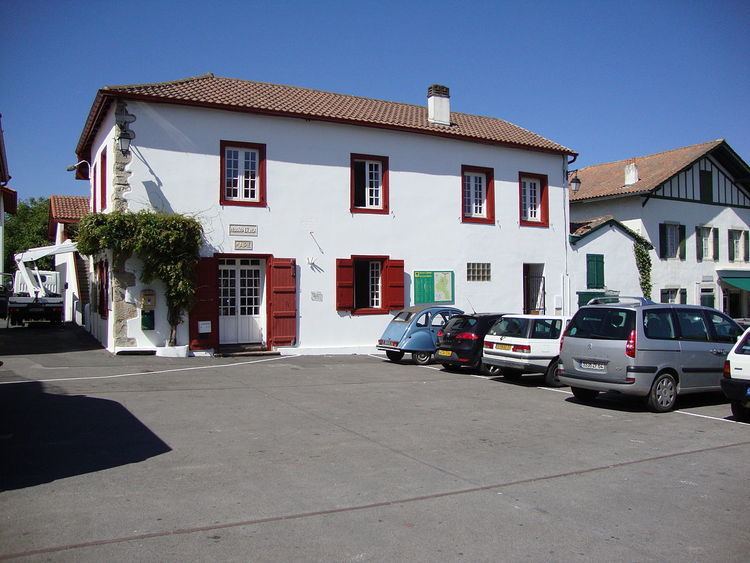 | ||
Intercommunality Agglomeration Sud Pays Basque | ||
Arbonne (Basque: Arbona) is a French commune in the Pyrénées-Atlantiques department in the Nouvelle-Aquitaine region of southwestern France.
Contents
- Geography
- Toponymy
- History
- Administration
- Inter communality
- Demography
- Economy
- Culture and Heritage
- Religious Heritage
- Facilities
- Notable people linked to the commune
- References
The inhabitants of the commune are known as Arbonars
Geography
Arbonne is located some 6 km south of Biarritz and 3 km east of Bidart. It is part of the Urban area of Bayonne and is located in the former province of Labourd. Access to the commune is by road D255 from Biarritz in the north passing through the village and continuing south to Saint-Pée-sur-Nivelle. The D655 branches off the D255 in the south of the commune and goes to Ahetze. The A63 autoroute passes through the northern tip of the commune but has no access from the commune. In the south of the commune is the hamlet of Le Hameau d'Arbonne. The rest of the commune is mainly farmland with patches of forest especially in the north.
Located in the drainage basin of the Adour, the commune is traversed by the Uhabia, a small coastal river that flows into the ocean at Bidart, and its tributaries: the Zirikolatzeko erreka and the Ruisseau d'Argelos.
The Ruisseau de Pemartin also flows through the commune and there is an extensive network of streams throughout the commune.
Toponymy
The commune name in Basque is Arbona.
Brigitte Jobbé-Duval indicated that 'Arbona meant "place of tree stumps".
The following table details the origins of the commune name and other names in the commune.
Sources:
Origins:
History
The oldest lord of Arbonne whose names are known are from the Sault family, Viscounts of Labourd. At the end of the 14th century the lordship was owned by the Saint-Julien family (originally from Lower Navarre) and then in 1408 to the Amezqueta family.
The Act of 4 March 1790, which determined the new administrative landscape of France by creating departments and districts, created the Department of Basses-Pyrénées to bring together Béarn, the Gascon lands in Bayonne and Bidache, and three French Basque provinces. For these three provinces three districts were created: Mauléon, Saint-Palais, and Ustaritz which replaced the Bailiwick of Labourd. The seat of Ustaritz was transferred almost immediately to Bayonne. Its Directorate pushed many municipalities into adopting new names conforming to the spirit of the Revolution. Arbonne was called Constante, Ustaritz became Marat-sur-Nive, Itxassou Union, Saint-Étienne-de-Baïgorry Thermopyles, Saint-Palais Mont-Bidouze, Saint-Jean-Pied-de-Port Nive-Franche, Louhossoa Montagne-sur-Nive, Saint-Jean-de-Luz Chauvin-Dragon, Ainhoa Mendiarte, and Souraïde Mendialde.
Administration
List of Successive Mayors
(Not all data is known)
Inter-communality
Arbonne is part of nine inter-communal structures:
The commune is part of the Eurocité basque Bayonne-San Sebastian (fr) (a cross-border association to develop the area from Bayonne in France to San Sebastian in Spain).
Demography
In 2009 the commune had 1,993 inhabitants. The evolution of the number of inhabitants is known from the population censuses conducted in the commune since 1793. From the 21st century, a census of communes with fewer than 10,000 inhabitants is held every five years, unlike larger towns that have a sample survey every year.
Sources : Ldh/EHESS/Cassini until 1962, INSEE database from 1968 (population without double counting and municipal population from 2006)
Economy
The commune is part of the Appellation d'origine contrôlée (AOC) zone of Ossau-iraty.
Culture and Heritage
According to the Map of the Seven Basque Provinces by Prince Louis-Lucien Bonaparte the basque dialect spoken in Arbonne is northern Upper Navarrese
Religious Heritage
The commune has two buildings that are registered as historical monuments:
Facilities
The commune has a general practitioner, three nurses, a speech therapist, a physiotherapist, and a dentist - all in the village centre.
Arbonne has two primary schools, one public and one private (Saint-Laurent school)
